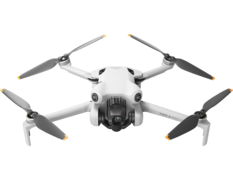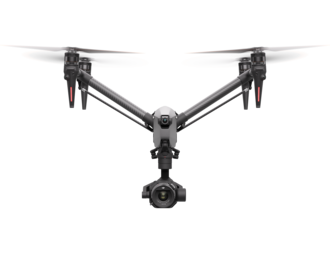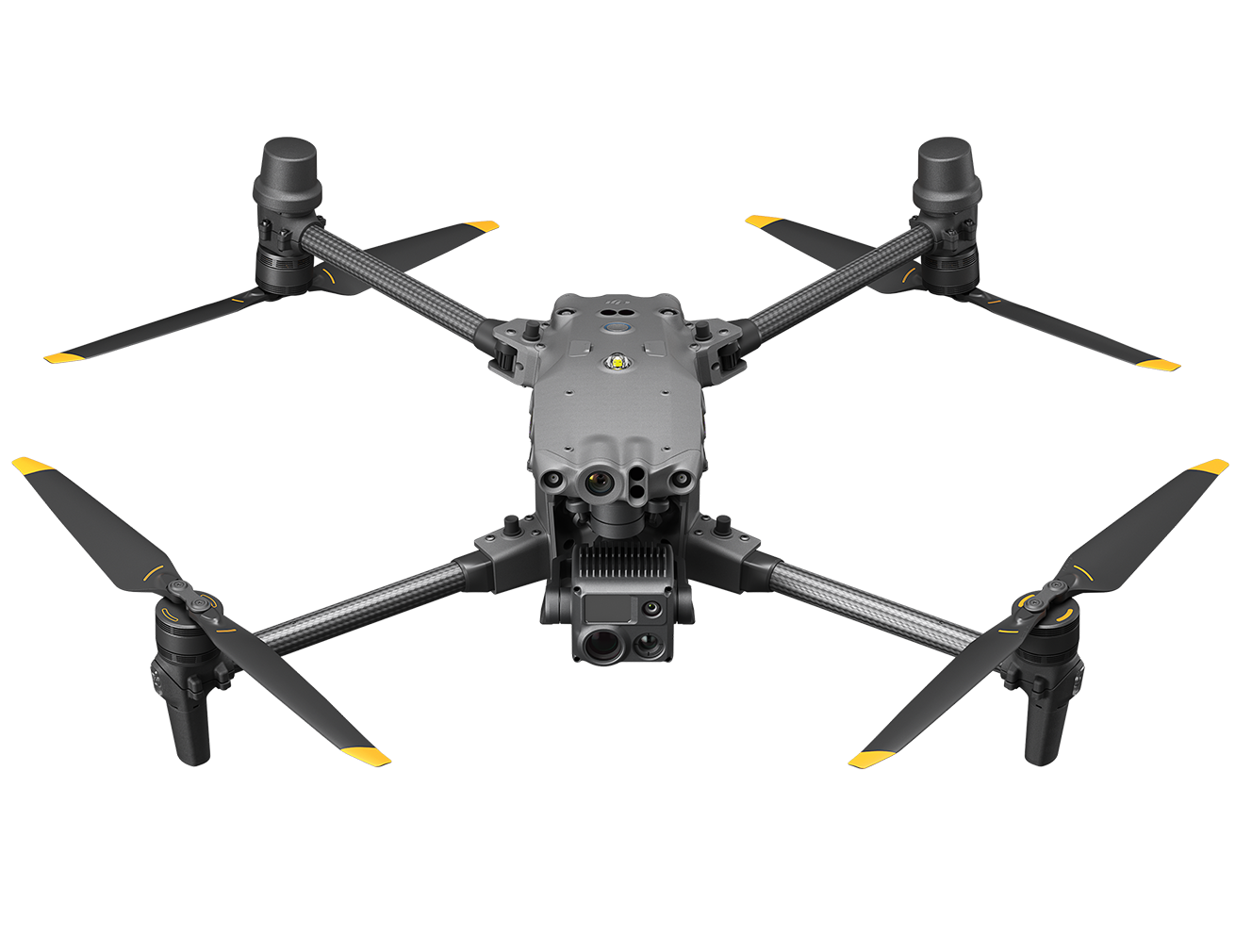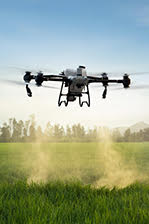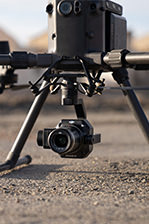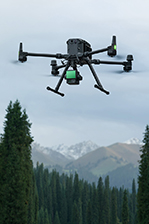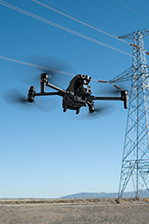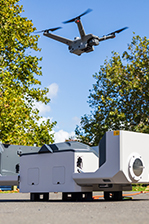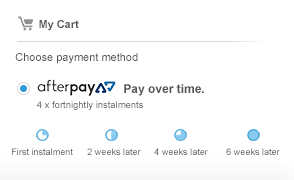DJI Mini 5 Pro Fly More Combo (DJI RC2)
Go Big With Mini
Mini 5 Pro features an ultra-light, palm-sized foldable design that slips easily into a backpack or pocket. With 42GB of internal storage, footage can be saved directly, ensuring uninterrupted flight enjoyment.
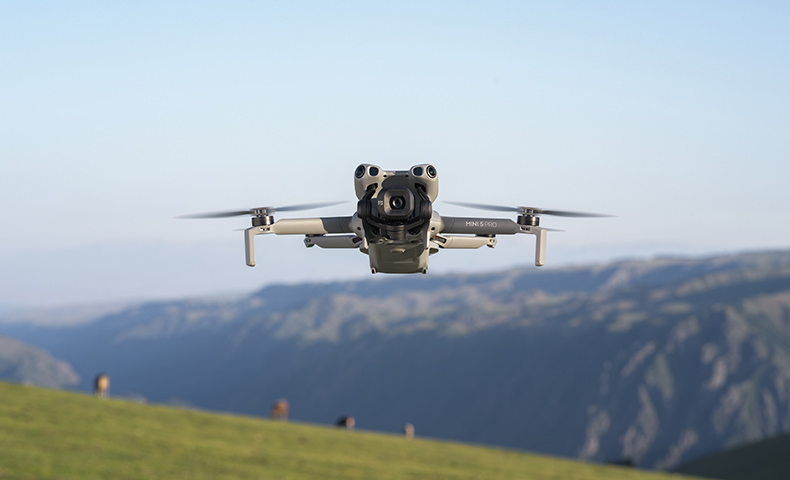
1-Inch CMOS Sensor, Capture Like a Pro
With a 50MP 1-inch CMOS sensor and f/1.8 aperture, Mini 5 Pro captures rich details and clean low-light shots. Compact in size, it delivers pro-level imaging.
Mini 5 Pro integrates a 1-inch CMOS sensor, supporting 4K/60fps HDR video recording with up to 14 stops of dynamic range for cinematic visuals [3]. This large sensor, enhanced by the new image-processing technology and intelligent algorithms [4], preserves even minute details in low-light conditions such as sunsets and nightscapes, delivering shots that are simply, effortlessly breathtaking. With the 48mm Med-Tele mode, subjects stand out more prominently in the frame, while portrait optimization algorithms [5] capture every expression with remarkable clarity.
Med-Tele Mode
With 2x zoom, the new 48mm Med-Tele mode now offers higher image resolution than the digital zoom on previous DJI Mini Pro series. Subjects stand out with greater texture, adding depth to your aerial shots.
Portrait Optimization [5]
Featuring DJI’s portrait optimization technology [5], DJI Mini 5 Pro enhances portraits’ brightness, contrast, and skin tones. Whether it’s a group shot or candid moment, portraits look naturally radiant with more vivid expressions. The 48mm Med-Tele mode further highlights subjects with true-to-life vibrance.
Compact, Yet Cinematic
4K/60fps HDR Video
The HDR video mode offers up to 14 stops of dynamic range [3], capturing cinematic footage in high-contrast scenes, such as detailed views of cloud textures and other elements during sunrise and sunset.
4K/120fps Slow-Motion Video
Mini 5 Pro supports slow-motion video recording at 4K/120fps, ensuring stunning clarity and fluidity with high resolution and frame rates. Dynamic details come to life, adding impact to footage and providing greater creative flexibility in post-production.
10-bit Video and High ISO Performance
Even in normal color mode, Mini 5 Pro can record 10-bit video using H.265 encoding, delivering refined color performance and greater flexibility in post, with the maximum ISO raised to 12800. In D-Log M and HLG color modes, the maximum ISO is raised to 3200, allowing for greater brightness and more details in urban night scenes.
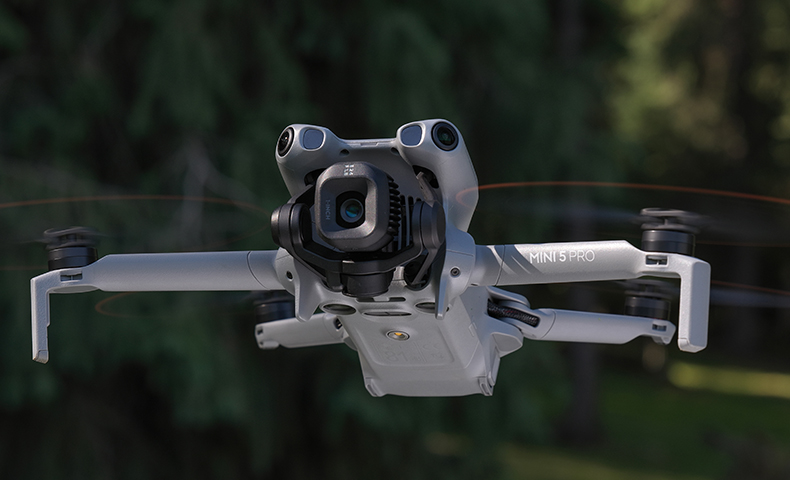
True Vertical Shooting and 225° Flexible Gimbal Rotation
Mini 5 Pro supports wide-angle roll rotation and true vertical shooting, bringing greater freedom and possibilities to camera movement. Both manual control and intelligent modes provide greater flexibility in camera angles and flight routes, allowing for more creative compositions. Even when shooting upward at tall buildings or from challenging angles, unique viewpoints that were once difficult to capture can now be achieved with ease, fully unlocking creative inspiration.
225° Gimbal Rotation for Dynamic Camera Movement
With 225° roll rotation, the gimbal enables flexible and dynamic camera movement. Paired with intelligent modes like QuickShot Rotate, Timelapse, Spotlight, and Waypoint Flight, capturing creative rotating footage is now easy.
True Vertical Shooting for Instant Sharing
Excellent for skyscrapers, waterfalls, and vibrant city scenes, instantly shoot vertical videos and photos and share. No cropping needed. Every photo and video is ready for social media, filling the screen with vibrant, full-frame brilliance.
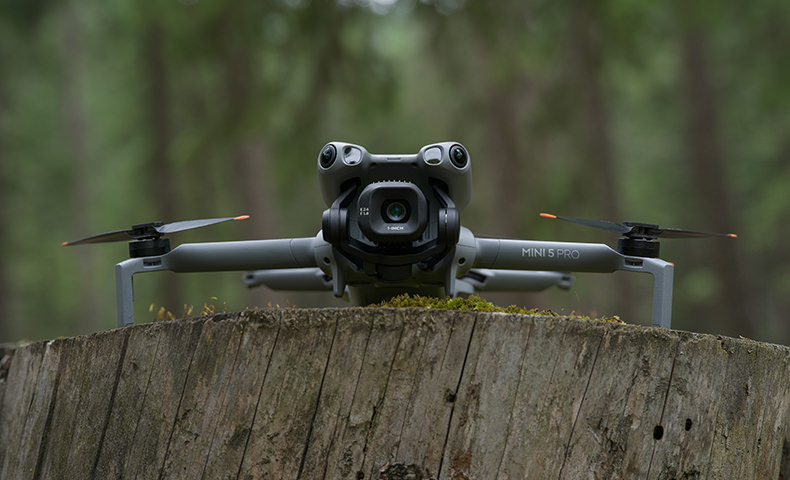
Confident Flight With Nightscape Omnidirectional Obstacle Sensing
Mini 5 Pro features a forward-facing LiDAR and multiple vision sensors for nightscape omnidirectional obstacle sensing [1], making return-to-home safer. In city nightscapes, it actively detects and avoids obstacles along flight and return paths for worry-free night flying. With sufficient light, it can memorize flight routes [6], enabling safe takeoff and return even without satellite signal.
Omnidirectional Vision Sensing System
Equipped with a forward-facing LiDAR, Mini 5 Pro features fisheye lenses on the front and rear for sensing forward, backward, left, right, and upward. The bottom is fitted with binocular lenses and a 3D infrared sensor, enabling omnidirectional obstacle sensing.
Nightscape Omnidirectional Obstacle Sensing [1]
Provides robust safety for night photography, allowing you to create with confidence and efficiency.
Nighttime RTH
With the forward-facing LiDAR, Mini 5 Pro detects obstacles like tall buildings even in low-light conditions and intelligently maneuvers upward [7], ensuring safer returns during nighttime flights.
Non-GNSS RTH
Powered by real-time vision positioning and map construction technologies, Mini 5 Pro memorizes flight paths [6] when adequate lighting is available. This ensures a safe return even when taking off from locations without satellite signals, such as balconies.
Dual-Band GNSS
With L1 + L5 dual-band GNSS, Mini 5 Pro connects to more satellites, for improved signal stability and precise positioning.
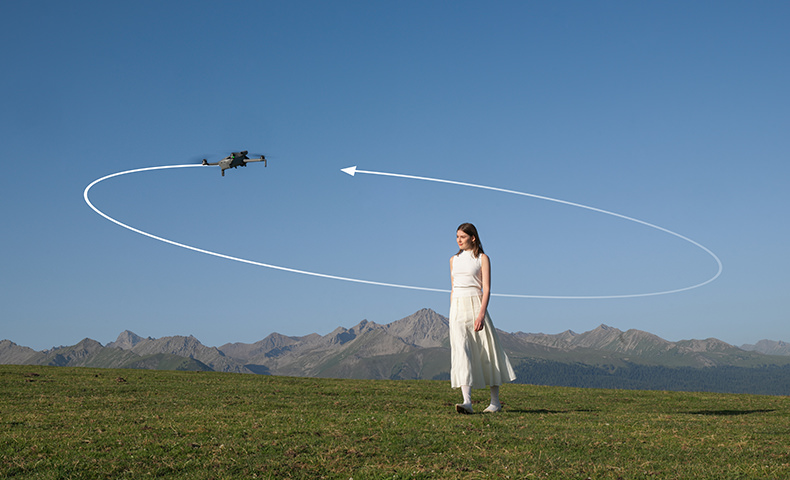
Upgraded ActiveTrack 360°
Mini 5 Pro captures every highlight, wherever you are. The upgraded ActiveTrack 360° offers customizable tracking in various scenarios, and features more stable and safer tracking performance [7].
Multi-Scenario Tracking
Mini 5 Pro detects sports scenarios and automatically selects Cycling or Standard mode for optimal framing and tracking. In Standard mode, the drone follows your path in real time, maintaining steady altitude and distance. In Cycling mode, it reacts quickly to turns and speed changes to keep you locked in and perfectly framed.
Smoother and Safer Tracking
Tracking performance has been enhanced to balance speed, agility, and safety. In open areas, the maximum tracking speed has been raised to 15 m/s [8] for quicker response. In complex environments, the drone can switch to rear tracking mode, steadily keeping the subject in focus and enabling creative freedom with confidence.
Intelligent Modes
MasterShots
Provides high-level camera movement templates according to portrait, close-up, and long-distance shooting needs.
QuickShots
Supports various modes such as QuickShot Rotate, Dronie, Circle, Helix, Rocket, Boomerang, and Asteroid, allowing you to easily shoot stylish short films.
Free Panorama
Supports Free Panorama, letting you create seamless panoramic shots by stitching together multiple images with a manually selected subject or area.
Off-State QuickTransfer
Mini 5 Pro supports remote wake-up via the DJI Fly app within Bluetooth range. Without taking out the drone or remote controller [9], files can be transferred at up to 100 MB/s [10] via Wi-Fi 6. Even when switching to other apps, the DJI Fly app continues downloading in the background.
Reliable Video Transmission and Extended Flight Time
Extended Flight Time With Faster Charging
The Intelligent Flight Battery provides up to 36 minutes of flight time [11], while the Intelligent Flight Battery Plus [12] offers up to 52 minutes [13] for extended creativity. Three Intelligent Flight Battery batteries can be fully charged in about 115 minutes [14], with fast charging for less downtime.
DJI O4+ 10-bit Video Transmission
O4+ video transmission supports a range of up to 20 km [15], using DJI’s latest transmission algorithm for stronger anti-interference and more stable, reliable live feeds.
Take Off From New Heights
Operating at altitudes up to 6000 meters [16], with an increased maximum ascent speed of 10 m/s [16] for agile vertical movement, Mini 5 Pro is ready for highland environments and wider horizons.
Notes
* All videos and images on this page were shot using DJI Mini 5 Pro by professionals in strict compliance with local laws and regulations and have been variously edited in post-production. All videos and images are for reference only. Actual results may vary. Always observe local laws and regulations and ensure the drone has obtained relevant certifications and airspace authorizations before flying.
** All data was tested using a production model DJI Mini 5 Pro in a controlled environment. Actual experience may vary depending on the environment, usage, and firmware version.
*** All images, videos, and screen display contents about the product itself on this page are for reference only. Actual product effects (including but not limited to appearance, color, size) and screen display contents (including but not limited to backgrounds, UI, and illustrations) may vary.
- Conditions for enabling Nightscape Omnidirectional Obstacle Sensing: The drone's front, back, left, right, and top sides are near textured surfaces with illuminance exceeding 1 lux. Similarly, the ground below is textured and diffusely reflective with a reflectivity above 20% (such as walls, trees, or people), also in lighting conditions with illuminance higher than 1 lux. DO NOT fly in severe weather conditions, such as in strong winds (wind speed of 12 m/s or more), snow, rain, lightning, or fog. DO NOT fly the drone 6000 m or higher above sea level. DO NOT fly the drone in environments where the temperature is below -10° C (14° F) or above 40° C (104° F). DO NOT take off from moving objects, such as cars or boats. DO NOT fly close to reflective surfaces such as water or snow. Otherwise, the vision system may not work correctly. The vision system may not work properly in dim environments. Always fly with caution and prevent the drone from entering Attitude mode. DO NOT fly near areas with magnetic or radio interference. Common magnetic or radio interference sources include Wi-Fi hotspots, routers, Bluetooth devices, high-voltage lines, large-scale power transmission stations, radar stations, mobile base stations, and broadcasting towers. Avoid sand entering the drone when taking off in desert or beach areas. Fly the drone in open areas away from crowds. Buildings, mountains, and trees may block the GNSS signal and affect the onboard compass.
- Using the Intelligent Flight Battery, the maximum flight time is 36 minutes. This is measured with the drone flying forward at a constant speed of 21.6 kph in a windless environment at sea level, with Obstacle Avoidance Action set to Brake and in photo mode, until forced landing due to low voltage. The Intelligent Flight Battery Plus extends the flight time to 52 minutes when flying forward at a constant speed of 25.2 kph. However, it is not sold in Europe, and its use there is not recommended. Always comply with local laws and regulations before flying.
- 14 stops of dynamic range are achievable for video on Auto mode but not for slow-motion video or 48mm Med-Tele mode.
- Compared to DJI Mini 4 Pro.
- Portrait optimization is only supported in normal color mode. This feature is not available in HLG and D-Log M modes.
- Conditions for memorizing flight paths: The drone's front, back, left, right, and top sides are near textured surfaces with illuminance exceeding 10 lux. Similarly, the ground below is textured and diffusely reflective with a reflectivity above 20% (such as walls, trees, or people), also in lighting conditions with illuminance higher than 10 lux. For balcony takeoff, ensure at least 2 × 2 meters of space and a height below 30 meters above ground for safe return to home. If the drone reaches its altitude limit while ascending around obstacles, it will hover at that height.
- It is recommended to use the ActiveTrack 360° feature in open environments. Refer to the user manual for unsupported scenarios or scenarios that may potentially interrupt recording. In complex environments with many obstacles, exercise caution when using Auto mode to ensure flight safety and personal safety.
- Measured in an open, windless test environment with the drone taking off from an altitude of 0 meters.
- DJI Mini 5 Pro maintains Bluetooth connectivity for 12 hours after it is powered off, allowing direct smartphone connections without powering up the drone again. Bluetooth deactivates automatically after 12 hours from drone power-off.
- Measured in a laboratory environment with little interference in countries/regions that support both 2.4 GHz and 5.8 GHz. Download speeds may vary depending on the actual conditions.
- Measured by the drone flying forward at a constant speed of 21.6 kph in a windless environment at sea level, with Obstacle Avoidance Action set to Brake, in photo mode, until forced landing due to low voltage. Data is for reference only. Always pay attention to reminders in the app during your flight.
- The Intelligent Flight Battery Plus is not sold in Europe. Do not use it in Europe. Always check and strictly abide by local laws and regulations before flying.
- Measured by the drone flying forward at a constant speed of 25.2 kph in a windless environment at sea level, with Obstacle Avoidance Action set to Brake, in photo mode, until forced landing due to low voltage. Data is for reference only. Always pay attention to reminders in the app during your flight.
- Charging time is measured in a test environment with a temperature of 25° C (77° F). Actual charging time may increase due to higher ambient temperatures or variations in mains voltage between regions.
- Measured in an outdoor, open environment, without interference, and with FCC compliance. The above data shows the farthest communication range for one-way, non-return flights. Always pay attention to reminders in the app during your flight.
- Measured using the Intelligent Flight Battery.
- Product weight may vary due to differences in batch materials and other factors. The actual weight is approximately 249.9 g ± 4 g and is subject to the actual product. Before flying with the Intelligent Flight Battery or the Intelligent Flight Battery Plus, check and comply with local laws and regulations to confirm whether registration or an exam is required.
- Forward obstacle sensing is supported only when flying in the Normal mode and Cine mode and during return-to-home. Intelligent functions do not support obstacle sensing.
Product Specifications
Takeoff Weight: 249.9 g
Product weight may vary due to differences in batch materials and other factors. The actual weight is approximately 249.9 g ± 4 g and is subject to the actual product. Before flying with the Intelligent Flight Battery or the Intelligent Flight Battery Plus, check and comply with local laws and regulations to confirm whether registration or an exam is required.
The Intelligent Flight Battery Plus is not sold in Europe.
Dimensions: Folded (without propellers): 157×95×68 mm (L×W×H)
Unfolded (with propellers): 255×181×91 mm (L×W×H)
Max Ascent Speed: 10 m/s (S Mode)
5 m/s (N Mode)
5 m/s (C Mode)
Max Descent Speed: 8 m/s (S Mode, using DJI Mini 5 Pro Intelligent Flight Battery Plus*)
6 m/s (S Mode, using DJI Mini 5 Pro Intelligent Flight Battery)
5 m/s (N Mode)
5 m/s (C Mode)
* The Intelligent Flight Battery Plus is not sold in Europe.
Max Horizontal Speed: 19 m/s* (S Mode, using DJI Mini 5 Pro Intelligent Flight Battery Plus**)
18 m/s* (S Mode, using DJI Mini 5 Pro Intelligent Flight Battery)
15 m/s*** (tracking status)
* Measured in a wind tunnel test environment when taking off from an altitude of 0 meter and ascending vertically to a height of 1.5 meters above the ground in Sport mode, and is for reference only. Always pay attention to reminders on the camera view during your flight.
** The Intelligent Flight Battery Plus is not sold in Europe.
*** Measured in an open, windless test environment with the drone taking off from an altitude of 0 meters.
Max Takeoff Altitude: 6000 m (using DJI Mini 5 Pro Intelligent Flight Battery)
4500 m (using DJI Mini 5 Pro Intelligent Flight Battery Plus*)
* The Intelligent Flight Battery Plus is not sold in Europe.
Max Flight Time: 36 minutes (using DJI Mini 5 Pro Intelligent Flight Battery)
Measured by the aircraft flying forward at a constant speed of 21.6 kph in a windless environment at sea level, with Obstacle Avoidance Action set to Brake, in photo mode, until forced landing due to low voltage. Data is for reference only. Always pay attention to reminders in the app during your flight.
52 minutes (using DJI Mini 5 Pro Intelligent Flight Battery Plus*)
Measured by the aircraft flying forward at a constant speed of 25.2 kph in a windless environment at sea level, with Obstacle Avoidance Action set to Brake, in photo mode, until forced landing due to low voltage. Data is for reference only. Always pay attention to reminders in the app during your flight.
* The Intelligent Flight Battery Plus is not sold in Europe.
Typical Flight Time: 21 minutes (using DJI Mini 5 Pro Intelligent Flight Battery)
33 minutes (using DJI Mini 5 Pro Intelligent Flight Battery Plus*)
Measured at sea level in a breezy environment, with the aircraft taking off with a fully charged battery, Obstacle Avoidance Action set to Brake, and the camera set to record at 4K/60fps. After takeoff, the aircraft ascends to 120 m and flies forward 1 km at 15 m/s before recording begins (about 15 minutes of recording with the Intelligent Flight Battery, and about 20 minutes with the Intelligent Flight Battery Plus). During recording, the aircraft adjusts gimbal movements and its flight position at speeds of up to 10 m/s over a total distance of approximately 2 km, while hovering for the remaining time. The aircraft hovers until a RTH reminder appears, then initiates auto RTH and completes a safe landing. Data is for reference only. Always pay attention to reminders in the app during your flight.
Max Flight Distance: 21 km (using DJI Mini 5 Pro Intelligent Flight Battery)
32 km (using DJI Mini 5 Pro Intelligent Flight Battery Plus*)
Measured by the aircraft flying forward at a constant speed of 39.6 kph in a windless environment at sea level, with Obstacle Avoidance Action set to Brake, in photo mode, until forced landing due to low voltage. Data is for reference only. Always pay attention to reminders in the app during your flight.
* The Intelligent Flight Battery Plus is not sold in Europe.
Max Wind Speed Resistance: 12 m/s
Max Pitch Angle: 38°
Operating Temperature: -10° to 40° C (14° to 104° F)
Global Navigation Satellite System: GPS + Galileo + BeiDou
Hovering Accuracy Range: Vertical:
±0.1 m (with vision positioning)
±0.5 m (with satellite positioning)
Horizontal:
±0.3 m (with vision positioning)
±0.5 m (with satellite positioning)
Internal Storage: 42 GB
Class: C0 (EU), with the option to apply for C1 (EU) in the DJI Fly app.
Image Sensor: 1-inch CMOS, 50MP Effective Pixels
Lens: FOV: 84°
Format Equivalent: 24 mm
Aperture: f/1.8
Focus: 0.5 m to ∞
ISO Range: Video
Normal:
100-12800 (Normal)
100-3200 (D-Log M)
100-3200 (HLG)
Slow Motion:
100-6400 (Normal)
100-3200 (D-Log M)
100-3200 (HLG)
Photo
100-6400 (12 MP)
100-3200 (50 MP)
Shutter Speed: 12MP Photo: 1/8000-2 s (2.5-8 s for simulated long exposure)
50MP Photo: 1/8000-2 s
Max Image Size: 8192×6144
Still Photography Modes: Single Shot: 12 MP and 50 MP
Burst Shooting: 12 MP, 3/5/7 frames; 50 MP, 3/5 frames
Automatic Exposure Bracketing (AEB): 12 MP, 3/5/7 frames; 50 MP, 3/5 frames at 0.7 EV step
Timed: 12 MP, 2/3/5/7/10/15/20/30/60 s; 50 MP, 5/7/10/15/20/30/60 s
Photo Format: JPEG/DNG (RAW)
"Video Resolution: H.264/H.265
4K: 3840×2160@24/25/30/48/50/60/120*fps
FHD: 1920×1080@24/25/30/48/50/60/120*/240*fps
* Recording frame rates. The corresponding video plays as a slow-motion video. Slow-motion videos and 4K video recordings only support H.265 encoding.
Video Format: MP4 (MPEG-4 AVC/H.264, HEVC/H.265)
Max Video Bitrate: H.264/H.265: 130 Mbps
* When shooting 4K/120fps video in D-Log M mode with DJI Mini 5 Pro, the video encoding bitrate can reach up to 130Mbps, corresponding to a video stream frame rate of 120fps. However, since slow-motion video files are encapsulated at 30fps, the video length displayed on the player is four times the recording duration, and the bitrate of the parsed encapsulated file is approximately one-fourth of the original encoding bitrate.
Supported File System: exFAT
Color Mode and Sampling Method: Normal (FHD):
8-bit 4:2:0 (H.264)
Normal (FHD/4K):
10-bit 4:2:0 (H.265)
HLG/D-Log M:
10-bit 4:2:0 (H.265)
Digital Zoom: 12MP Photo: 1-3x
4K: 1-3x
FHD: 1-4x
Stabilization: 3-axis mechanical gimbal (tilt, roll, pan)
Mechanical Range: Tilt: -135° to 80°
Roll: -230° to 95°
Pan: -25° to 25°
Controllable Range: Tilt: -90° to 55°
Roll: -180° to 45°
Max Control Speed (tilt): 100°/s
Angular Vibration Range: ±0.005°
Sensing Type: Omnidirectional binocular vision system, supplemented with forward-facing LiDAR and an infrared sensor at the bottom of the aircraft
Forward: Measurement Range: 0.5-18 m
Detection Range: 0.5-200 m
Effective Sensing Speed: Flight Speed ≤ 15 m/s
FOV: Horizontal 90°, Vertical 72°
Backward: Measurement Range: 0.5-18 m
Effective Sensing Speed: Flight Speed ≤ 14 m/s
FOV: Horizontal 90°, Vertical 72°
Lateral: Measurement Range: 0.5-12 m
Effective Sensing Speed: Flight Speed ≤ 14 m/s
FOV: Horizontal 90°, Vertical 72°
Upward: Measurement Range: 0.5-18 m
Effective Sensing Speed: Flight Speed ≤ 6 m/s
FOV: Front and Back 72°, Left and Right 90°
Downward: Measurement Range: 0.3-14 m
Effective Sensing Speed: Flight Speed ≤ 6 m/s
FOV: Front and Back 106°, Left and Right 90°
Operating Environment: Forward, Backward, Left, Right, and Upward:
Surfaces with discernible patterns and adequate lighting (lux > 1)
Downward:
Surfaces with discernible patterns, diffuse reflectivity > 20% (e.g., walls, trees, people), and adequate lighting (lux > 1)
3D Infrared Sensor: Forward-Facing LiDAR
Measurement Range (nighttime): 0.5-25 m (reflectivity > 10%)
FOV: Up and Down 60°, Left and Right 60°
Downward-Facing Infrared Sensor
Measurement Range: 0.3-8 m (reflectivity > 10%)
FOV: Front and Back 60°, Left and Right 60°
Video Transmission System: O4+
Live View Quality: Remote Controller:
1080p/30fps, 1080p/60fps
Operating Frequency: 2.400-2.4835 GHz
5.170-5.250 GHz
5.725-5.850 GHz
Operating frequency allowed varies among countries and regions. Refer to local laws and regulations for more information.
Transmitter Power (EIRP) : 2.4 GHz:
< 33 dBm (FCC)
< 20 dBm (CE/SRRC/MIC)
5.1 GHz:
< 23 dBm (CE)
5.8 GHz:
< 33 dBm (FCC)
< 30 dBm (SRRC)
< 14 dBm (CE)
Max Transmission Distance (unobstructed, free of interference): FCC: 20 km
CE: 10 km
SRRC: 10 km
MIC: 10 km
Measured in an unobstructed outdoor environment free of interference. The above data shows the farthest communication range for one-way, non-return flights under each standard. Always pay attention to RTH reminders in the app during your flight.
Max Transmission Distance (unobstructed, with interference): Strong Interference: Urban landscape, approx. 1.5-4 km
Medium Interference: Suburban landscape, approx. 4-10 km
Low Interference: Suburb/Seaside, approx. 10-20 km
Measured under FCC standard in unobstructed environments with typical interference. Used for reference purposes only and provides no guarantee for actual transmission distance.
Max Transmission Distance (obstructed, with interference): Low Interference and Obstructed by Buildings: Approx. 0-0.7 km
Low Interference and Obstructed by Trees: Approx. 0.7-4.5 km
Measured under FCC standard in obstructed environments with typical low interference. Used for reference purposes only and provides no guarantee for actual transmission distance.
Max Download Speed: O4+:
10 MB/s (with DJI RC-N3 Remote Controller)
10 MB/s (with DJI RC 2)
Wi-Fi 6: Up to 100 MB/s*
* Measured in a laboratory environment with little interference in countries/regions that support both 2.4 GHz and 5.8 GHz. Download speeds may vary depending on the actual conditions.
Lowest Latency: Aircraft + Remote Controller: Approx. 120 ms
Depending on the actual environment and mobile device.
Antenna: 4 antennas, 2T4R
Protocol: 802.11 a/b/g/n/ac/ax
Operating Frequency: 2.400-2.4835 GHz
5.725-5.850 GHz
Transmitter Power (EIRP): 2.4 GHz:
< 20 dBm (FCC/CE/SRRC/MIC)
5.8 GHz:
< 26 dBm (FCC/SRRC)
< 14 dBm (CE)
Protocol: Bluetooth 5.4
Operating Frequency: 2.400-2.4835 GHz
Transmitter Power (EIRP): < 10 dBm
Capacity: DJI Mini 5 Pro Intelligent Flight Battery: 2788 mAh
DJI Mini 5 Pro Intelligent Flight Battery Plus*: 4680 mAh
* The Intelligent Flight Battery Plus is not sold in Europe.
Weight: DJI Mini 5 Pro Intelligent Flight Battery: approx. 71.9 g
DJI Mini 5 Pro Intelligent Flight Battery Plus*: approx. 117 g
* The Intelligent Flight Battery Plus is not sold in Europe.
Nominal Voltage: DJI Mini 5 Pro Intelligent Flight Battery: 7.16 V
DJI Mini 5 Pro Intelligent Flight Battery Plus*: 7 V
* The Intelligent Flight Battery Plus is not sold in Europe.
Max Charging Voltage: DJI Mini 5 Pro Intelligent Flight Battery: 8.6 V
DJI Mini 5 Pro Intelligent Flight Battery Plus*: 8.6 V
* The Intelligent Flight Battery Plus is not sold in Europe.
Battery Type: Li-ion
Chemical System: LiNiMnCoO2
Energy: DJI Mini 5 Pro Intelligent Flight Battery: 19.52 Wh
DJI Mini 5 Pro Intelligent Flight Battery Plus*: 33.51 Wh
* The Intelligent Flight Battery Plus is not sold in Europe.
Charging Temperature: 5° to 40° C (41° to 104° F)
Charging Time: DJI Mini 5 Pro Intelligent Flight Battery:
1 battery can be fully charged in approx. 69 minutes by charging through the drone using the DJI 65W Portable Charger.
1 battery can be fully charged in approx. 46 minutes using the Two-Way Charging Hub and DJI 65W Portable Charger.
3 batteries can be fully charged in approx. 115 minutes using the Two-Way Charging Hub and DJI 65W Portable Charger.
DJI Mini 5 Pro Intelligent Flight Battery Plus*:
1 battery can be fully charged in approx. 94 minutes by charging through the drone using the DJI 65W Portable Charger.
1 battery can be fully charged in approx. 56 minutes using the Two-Way Charging Hub and DJI 65W Portable Charger.
3 batteries can be fully charged in approx. 193 minutes using the Two-Way Charging Hub and DJI 65W Portable Charger.
Charging time is measured in a test environment with a temperature of 25°C. Actual charging time may increase due to higher ambient temperatures or variations in mains voltage between regions.
* The Intelligent Flight Battery Plus is not sold in Europe.
Input: USB-C: 5-15 V, max 4.3 A
Output: Battery Port: 5-15 V, max 2 A
Charging Type: DJI Mini 5 Pro Intelligent Flight Battery: Two batteries charged in parallel
DJI Mini 5 Pro Intelligent Flight Battery Plus*: Three batteries charged in sequence
* The Intelligent Flight Battery Plus is not sold in Europe.
Compatibility: DJI Mini 5 Pro Intelligent Flight Battery
DJI Mini 5 Pro Intelligent Flight Battery Plus*
* The Intelligent Flight Battery Plus is not sold in Europe.
Recommended microSD Cards: Lexar Silver plus 64GB A2 V30 microSDXC
Lexar Silver plus 128GB A2 V30 microSDXC
Lexar Silver plus 256GB A2 V30 microSDXC
Lexar Silver plus 512GB A2 V30 microSDXC
Lexar Silver plus 1TB A2 V30 microSDXC
Kingston CANVAS GO! Plus 64GB A2 V30 microSDXC
Kingston CANVAS GO! Plus 128GB A2 V30 microSDXC
Kingston CANVAS GO! Plus 256GB A2 V30 microSDXC
Kingston CANVAS GO! Plus 512GB A2 V30 microSDXC
Max Operating Time: Without charging any mobile device: 3.5 hours
When charging a mobile device: 1.5 hours
Max Supported Mobile Device Size: 180×86×10 mm (L×W×H)
Operating Temperature: -10° to 40° C (14° to 104° F)
Charging Temperature: 5° to 40° C (41° to 104° F)
Charging Time: 2 hours
Charging Type: It is recommended to use a 5V/2A charger.
Battery Capacity: 9.36 Wh (3.6 V, 2600 mAh)
Weight: Approx. 320 g
Dimensions: 104.2×150×45.2 mm (L×W×H)
Supported Mobile Device Port Type: Lightning, USB-C, Micro-USB
Using a mobile device with a Micro-USB port requires the DJI RC-N Series RC Cable (Standard Micro USB Connector), which is sold separately.
Video Transmission Operating Frequency: 2.400-2.4835 GHz
5.170-5.250 GHz
5.725-5.850 GHz
Operating frequency allowed varies among countries and regions. Refer to local laws and regulations for more information.
Video Transmission Transmitter Power (EIRP): 2.4 GHz:
< 33 dBm (FCC)
< 20 dBm (CE/SRRC/MIC)
5.1 GHz:
< 23 dBm (CE)
5.8 GHz:
< 33 dBm (FCC)
< 14 dBm (CE)
< 30 dBm (SRRC)
In the box
DJI Mini 5 Pro × 1
DJI RC 2 Controller × 1
DJI Mini 5 Pro Intelligent Flight Battery × 3
DJI Mini 5 Pro Spare Propeller (Pair) × 3
DJI Mini 5 Pro Two-Way Charging Hub × 1
DJI Mini 5 Pro Shoulder Bag × 1
USB-C to USB-C Data Cable × 1
DJI Mini 5 Pro Storage Cover × 1
DJI Mini 5 Pro ND Filter Set (ND8/32/128) × 1
WHY BUY FROM US?
By buying from Ferntech, you'll have the confidence that you are dealing directly with New Zealand's leading drone experts. Our staff are knowledgable drone pilots who offer expert advice, trusted support and superior specialist service. Only through us will you receive a full New Zealand warranty, phone and email support, and access to our certified Repairs Centre with DJI-qualified drone technicians. And we guarantee that we will have the best prices on the market — if not let us know and we will match any price (conditions apply).
Warranty Details
1 year warranty
Product
Compared with DJI Mini 4 Pro, what are the main improvements of DJI Mini 5 Pro?
DJI Mini 5 Pro has comprehensive improvements in the camera system, vision sensing system, flight performance, and video transmission system. The main improvements include:
1. Camera System: Mini 5 Pro features a 1-inch CMOS sensor and a new image processing platform, delivering up to 14 stops of HDR video dynamic range [1]. It introduces a 48mm Med-Tele mode (2x zoom) and utilizes DJI's portrait optimization technology [2] for exceptional portrait photography.
2. Flexible Gimbal Rotation: The gimbal offers 225° of roll rotation, which can be controlled manually or through intelligent modes such as QuickShot Rotate, Timelapse, Spotlight, and Waypoint Flight, enabling effortless creation of dynamic rotational footage.
3. Sensing System: Mini 5 Pro features forward-facing LiDAR, supporting 1-lux nightscape omnidirectional obstacle sensing [3] and next-gen Smart RTH. It can actively detect and avoid obstacles such as buildings along the flight and return paths, ensuring safer urban nightscape photography. It can also memorize flight paths in well-lit conditions, enabling quick takeoffs and safe returns even without satellite signals [3].
4. ActiveTrack: Mini 5 Pro intelligently detects different sports scenarios and automatically selects Cycling or Standard mode to ensure optimal framing and tracking. Tracking performance has been enhanced to balance speed, agility, and safety.
5. Flight Performance [4]: The Intelligent Flight Battery offers up to 36 minutes of flight time, a maximum takeoff altitude of 6000 meters, and a maximum forward flight speed of 18 m/s. The Intelligent Flight Battery Plus extends flight time to 52 minutes, with a maximum takeoff altitude of 4500 meters and a maximum forward flight speed of 19 m/s.
6. Video Transmission: DJI O4+ Video Transmission offers up to 20 km of 10-bit HDR video transmission [5], with stronger signal stability, enhanced anti-interference capabilities, and superior image quality.
7. Off-State QuickTransfer: Mini 5 Pro has 42GB of internal storage. Mini 5 Pro supports remote wake-up via the DJI Fly app within Bluetooth range, enabling high-speed file transfers at up to 100MB/s [6].
8. Battery Charging Efficiency [7]: Using the DJI 65W Portable Charger and charging via the Two-Way Charging Hub, it takes approximately 46 minutes to fully charge a single Intelligent Flight Battery (about 56 minutes for a single Intelligent Flight Battery Plus). Fully charging three Intelligent Flight Batteries takes about 115 minutes in total (about 193 minutes for three Intelligent Flight Battery Plus units).
1. 14 stops of dynamic range are achievable for video on Auto mode but not for slow-motion video or 48mm Med-Tele mode.
2. Only available in Normal mode and not supported in HLG or D-Log M.
3. Nightscape omnidirectional obstacle sensing requires discernible textures and over 1 lux illumination; flight route memorization requires discernible textures and over 10 lux illumination. Refer to the official DJI website or the product's user manual for details.
4. The flight time and the maximum forward speed were measured in laboratory conditions, while the maximum takeoff altitude was measured in a high-altitude environment. Refer to the Spec page on the official DJI website or the product's user manual for details.
5. Measured in an outdoor, open environment, without interference, and with FCC compliance. The above data shows the farthest communication range for one-way, non-return flights. Always pay attention to reminders in the app during your flight.
6. Measured in a laboratory environment with little interference in countries/regions that support both 2.4 GHz and 5.8 GHz. Download speeds may vary depending on the actual conditions.
7. Charging time is measured in a test environment with a temperature of 25° C (77° F). Actual charging time may increase due to higher ambient temperatures or variations in mains voltage between regions.
What is the certification level of DJI Mini 5 Pro in Europe?
DJI Mini 5 Pro is C0 certified by the European Union Aviation Safety Agency (EASA). To request a switch to EU C1 classification, contact DJI Support via the DJI Fly app.
Is DJI Mini 5 Pro waterproof?
No. Avoid contact with water during use, as it may damage the device.
If it rains during the flight, return and land as soon as possible, and wait until the drone is fully dry inside and out before using it again.
What app do I need to install before using DJI Mini 5 Pro?
DJI Mini 5 Pro can only be used with the DJI Fly app. You can download the latest version of DJI Fly from the DJI Mini 5 Pro Downloads page on the official DJI website.
If you use DJI RC 2 as the remote controller, it comes with the pre-installed DJI Fly app.
What should I be aware of regarding the forward-facing LiDAR?
1. Dirt and debris can lead to false obstacle detection. Keep the forward-facing LiDAR clean to ensure accurate obstacle sensing.
2. The LiDAR works automatically in moderately lit environments, but it will not function properly in bright light. Pay attention to ambient light conditions to maintain safe flight operations.
What are the benefits of the forward-facing LiDAR?
1. Enhanced Nighttime Obstacle Sensing: Even in extremely dark conditions where the ambient light is less than 1 lux and the vision sensing system becomes ineffective, the forward-facing LiDAR can still provide forward obstacle sensing for the drone. This ensures that the drone can detect obstacles and perform timely stops at night.
2. Safer Nighttime RTH: During nighttime return-to-home operations, if the vision sensing system is ineffective, the drone can use the forward-facing LiDAR to sense forward obstacles and navigate upwards to avoid them*, making the return flight safer.
* If the drone reaches its altitude limit while ascending around obstacles, it will hover at that height.
Camera
How do I enable HDR mode on DJI Mini 5 Pro?
When recording video at 60fps or lower, DJI Mini 5 Pro enables HDR mode by default.
Remote Controller
Does DJI RC 2 support quick charging?
Yes. The USB-C port supports power input up to 9V/3A (with 9V/3A charger).
How do I customize button functions of DJI RC 2?
You can customize the C1/C2 button, the right dial, and other controls of DJI RC 2 in the DJI Fly app for more convenient control.
Does DJI RC 2 support installing third-party apps?
No.
Video Transmission
Does the max transmission distance of the O4+ video transmission system vary according to the interference level of the environment?
In different environments, the wireless interference level is different, and the max transmission distance will vary.
Unobstructed:
Strong Interference: Urban landscape, approx. 1.5-4 km
Medium Interference: Suburban landscape, approx. 4-10 km
Low Interference: Suburb/seaside, approx. 10-20 km
Obstructed:
Low Interference and Obstructed by Buildings: approx. 0-0.7 km
Low Interference and Obstructed by Trees: approx. 0.7-4.5 km
Data tested under FCC standard in obstructed or unobstructed environments with typical interference. Used for reference purposes only and provides no guarantee for actual transmission distance.
Firmware Update
How do I update the firmware of DJI Mini 5 Pro?
When the drone is connected to the remote controller and a new firmware version is available, the DJI Fly app will send you a firmware update prompt. You can follow the instructions to update the firmware for the drone, remote controller, battery, and other devices.
You can also update via the DJI Assistant 2 (Consumer Drones Series) software on a computer. The latest version of the software can be downloaded from the DJI Mini 5 Pro Downloads page on the official DJI website.
What factors can lead to an update failure?
1. The battery level of the drone or remote controller is below 20%.
2. The drone or the remote controller is powered off during an update. If this happens, restart the drone and remote controller, and try again.
3. The network is disconnected during a firmware download.
4. Your smartphone interface is switched to other apps during a firmware download.
The drone will restart multiple times during an update and automatically power off after completing the update.
There's currently no reviews for this product, be the first to write one.



